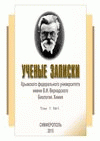Ялта, Республика Крым, Россия
В статье представлены результаты изучения массовой доли и компонентного состава эфирного масла (ЭМ) Pelargonium graveolens L'Hйr. в условиях открытого грунта Южного берега Крыма. Эфирное масло получали методом гидродистилляции на аппаратах Гинзберга. Компонентный состав эфирного масла определяли с помощью аппаратно-программного комплекса на базе хроматографа «Хроматэк-Кристалл 5000.2». Массовая доля ЭМ в свежесобранном сырье составила 0,22 %. Эфирное масло представлено 41 компонентом, 87,8 % из которых идентифицированы. Установлено, что количественно преобладающими компонентами ЭМ изучаемого образца P. graveolens являются: терпеновые спирты: цитронеллол – 39,67 %, гераниол – 13,61 % и терпеновый эфир – цитронеллил формиат 10,58 %. Полученные результаты позволяют рассматривать P. graveolens для условий ЮБК как ценный сырьевой источник с целью получения натурального ЭМ отечественного производства для нужд фармацевтической, парфюмерно-косметической и пищевой отраслей промышленности.
Pelargonium graveolens L'Hйr., эфирное масло, массовая доля, компонентный состав, Южный берег Крыма
1. Gutieva N. M. Atlas of large-flowered pelargonium varieties that are promising for the subtropics of the Russian Federation, 100 p. (Sochi: Federal Scientific Research Center of the Russian Academy of
2. Rabotyagov V. D., Paliy A. E., Kurdyukova O. N. Essential oils of aromatic plants. 208 p. (Simferopol: IT “Arial”, 2018). (in Russ.).
3. Singh P., Khan S., Kumar S., Rahman L. Plant Cell, Tissue and Organ Culture (PCTOC), 129 (1), 35 (2017). DOI:https://doi.org/10.1007/s11240-016-1153-8 EDN: https://elibrary.ru/WKOIIN
4. Peterson A., Machmudah S., Roy B. C., Goto M., Sasaki M., Hirose T. Extraction of essential oil from geranium (Pelargonium graveolens) with supercritical carbon dioxide. Journal of Chemical Technology
5. Filippova A. A., Szhenova T. M., Golovina N. V., Garnova N. Yu., Bokov D. O. Standardization of geranium essential oil. Bulletin of Moscow University. Ser. 2. Chemistry, 61(3), 249 (2020). (in Russ.).
6. Lis-Balchin M., Geranium and pelargonium. The genera Geranium and Pelargonium, 116 (Taylor & Francis London: CRC Press, 2002.
7. Abe S., Maruyama N., Hayama K., Inouye S., Oshima H., Yamaguchi H. Suppression of neutrophil recruitment in mice by geranium essential oil. Mediators of Inflammation, 13, 21 (2004).
8. Ananthan R., Latha M., Ramkumar K. M., Pari L., Baskar C., Narmatha BMV. Modulatory effects of Gymnema montanum leaf extract on alloxan-induced oxidative stress in Wistar rats. Nutrition, 20, 280 (2004).
9. Maruyama N., Sekimoto Y., Ishibashi H., Inouye S., Oshima H., Yamaguchi H., Abe S. Suppression of neutrophil accumulation in mice by cutaneous application of geranium essential oil. Journal
10. Silva N. C., Fernandes A. J. Biological properties of medicinal plants: a review of their antimicrobial activity. Journal of Venomous Animals and Toxins Including Tropical Diseases, 16, 402 (2010).
11. Edwards-Jones V., Buck R., Shawcross S. G., Dawson M. M., Dunn K. The effect of essential oils on methicillin-resistant Staphylococcus aureus using a dressing model. Burns, 30(8), 772 (2004).
12. Carmen G., Hancu G. Antimicrobial and antifungal activity of Pelargonium roseum essential oils. Advanced Pharmaceutical Bulletin, 4(2), 511. (2014).
13. Giongo J. L., Vaucher R., Borin D. I., Correa M. S., Dos Santos V. B., Santos R. C., Boligon A. A., Athayde M. L., Bonez P. C., Rossi G. G., De Campus M. M. Antimycobacterial, antimicrobial and
14. Narnoliya L. K., Jadaun J. S., Singh, S. P. The Phytochemical Composition, Biological Effects and Biotechnological Approaches to the Production of High-Value Essential Oil from Geranium. In: Malik, S.
15. Rath C. C., Dash S. K., Rao B. R. Antifungal activity of rose-scented geranium (Pelargonium species) essential oil and its six constituents. Journal of Essential Oil Bearing Plants, 8(2), 218 (2005).
16. Rosato A., Vitali C., Gallo D., Balenzano L., Mallamaci R. The inhibition of Candida species by selected essential oils and their synergism with amphotericin B. Phytomedicine, 15, 635 (2008).
17. Bouzenna H., Krichen L. Pelargonium graveolens L’Her. and Artemisia arborescens L.essential oils: chemical composition, antifungal activity against Rhizoctonia solani and insecticidal activity against
18. Naeini A. R., Nazeri M., Shokri H. Antifungal activity of Zataria multiflora, Pelargonium graveolens and Cuminum cyminum essential oils towards three species of Malassezia isolated from patients with
19. Shin S., Lim S. Antifungal effects of herbal essential oils alone and in combination with ketoconazole against Trichophyton spp. Journal of Applied Microbiology, 97, 1289 (2004).
20. Lis-Balchin M. Aromatherapy science: A guide for healthcare professionals, 112 (London: Pharmaceutical Press, 2006).
21. Mohamed N. B., Abdelkrim K., Fairouz S. Essential oil of Algerian rose-scented geranium (Pelargonium graveolens): Chemical composition and antimicrobial activity against food spoilage pathogens. Food
22. Seo S. M., Kim J., Lee S. G., Shin C. H., Shin S. C., Park I. K. Fumigant antitermitic activity of plant essential oils and components from Ajowan (Trachyspermumammi), Allspice (Pimentadioica), caraway
23. Sabzghabaee A. M., Shirdare Z., Ebadian B., Aslani A., Ghannadi A. Clinical evaluation of the essential oil of Pelargonium graveolens for the treatment of denture stomatitis. Dental Research Journal, 1, 105 (2011).
24. Ponomareva E. I., Molokhova E. I., Kholov A. K. Identification of components of essential oil of fragrant geranium (Pelargonium graveolens L'H.) by thin layer chromatography. Chemistry for sustainable
25. Shevchuk O. I., Isikov V. P., Logvinenko L. A. Methodological and methodological aspects of the introduction and selection of aromatic and medicinal plants / Ed. editor, corresponding member RAS
26. Adams R. P. Identification of essential oil compounds by gas chromatography/quadrupole mass spectroscopy. – Allured Pub. Corp., USA, 2007. – 804 p.
27. Tkachev A.V. Study of plant volatile substances, 969 (Novosibirsk: “Ofset”, 2008). (in Russ.).
28. Marko N.V., Logvinenko L.A., Shevchuk O.M., Feskov S.A. Annotated catalog of aromatic and medicinal plants from, 176 (Simferopol: IT “ARIAL”, 2018). (in Russ.).
29. Azonov D. A., Kholov A. K., Razykova G. V. The healing properties of Geranoretinol and essential oils, 156 (Tashkent: Matbuot Publishing House, 2011). (in Russ.).
30. Babu K. G., Kaul V. K. Variation in essential oil composition of rose-scented geranium (Pelargonium sp.) distilled by different distillation techniques. Flavour and Fragrance Journal, 20(2), 222 (2005).
31. Kholov A. K., Azonov D. A. Essential oil plants and essential oils – sources of biologically active substances (literature review). Bulletin of the Tajik National University (scientific journal) series of
32. Priscila L. Santos, Joo Pedro S. C. F. Matos, Laurent Picot, Jackson R. G. S. Almeida, Jullyana S. S. Quintans, Lucindo J. Quintans-Jnior. Citronellol, a monoterpene alcohol with promising pharmacological
33. Qneibi M., Jaradat N., Emwas N. Effect of Geraniol and Citronellol Essential Oils on the Biophysical Gating Properties of AMPA Receptors. Applied Sciences, 9(21), 4693.
34. Jayaraj R. L., Azimullah S., Parekh K. A., Ojha S. K., Beiram R. Effect of citronellol on oxidative stress, neuroinflammation and autophagy pathways in an in vivo model of Parkinson's disease.
35. Gonzalez-Audino P., Picollo M.I., Gallardo A., Toloza A., Vassena, C., MougabureCueto G. Comparative toxicity of oxygenated monoterpenoids in experimental hydroalcoholic lotions to permethrin-
36. Michaelakis A., Vidali V. P., Papachristos D. P., Pitsinos E. N., Koliopoulos G., Couladouros E. A., Polissiou M. G., Kimbaris A. C. Bioefficacy of acyclic monoterpenes and their saturated derivatives against the
37. Zore G. B., Thakre A. D., Rathod V., Karuppayil S. M. Evaluation of anti-Candida potential of geranium oil constituents against clinical isolates of Candida albicans differentially sensitive to
38. Mączka W., Wińska K., Grabarczyk M. One Hundred Faces of Geraniol. Molecules, 21;25(14), 3303 (2020). DOI:https://doi.org/10.3390/molecules25143303.
39. Sato K., Krist S., Buchbauer G. Antimicrobial effect of vapours of geraniol, (R)-(−)-linalool, terpineol, γ-terpinene and 1,8-cineole on airborne microbes using an airwasher. Flavour and Fragrance Journal, 22, 435
40. Papachristos D. P., Karamanoli K. I., Stamopoulos D. C., Menkissoglu-Spiroudi U. The relationship between the chemical composition of three essential oils and their insecticidal activity against
41. De Cssia da Silveira, e.S.R., Andrade, L. N.; de Sousa, D. P. A review on antiinflammatoryactivity of monoterpenes. Molecules, 18, 1227 (2013).
42. Navarro M. C., Noguera M. A., Romero M. C., Montilla M. P., Gonzez de Selgas J. M., Valero A. Anisakis simplex s.l.: Larvicidal activity of various monoterpenic derivatives of natural origin against L3 larvae in
43. Eisenacher M., Beschnitt S., Hderich W. Novel route to a fruitful mixture of terpene fragrances in particular phellandrene starting from natural feedstock geraniol using weak acidic boron based catalyst.
44. Interstate standard GOST ISO 4731-2014 "Essential oil of geranium (Pelargonium x ssp.). Technical conditions.", 12. (in Russ.).
45. Isagulyants V. I. Synthetic fragrances (chemistry and technology). 2nd ed., 831 (Yerevan: Publishing house. Academy of Sciences of the Armenian SSR, 1946). (in Russ.).





